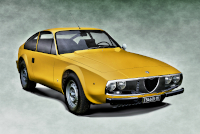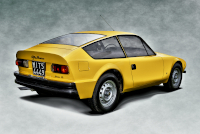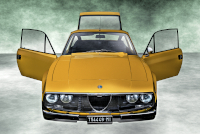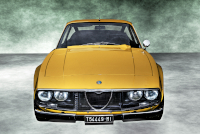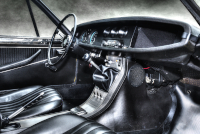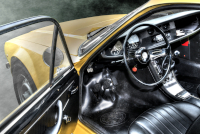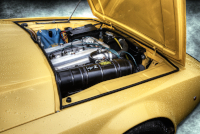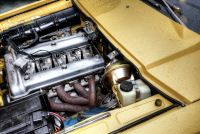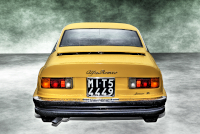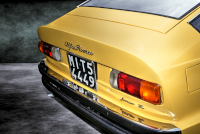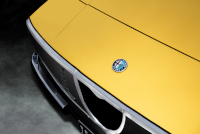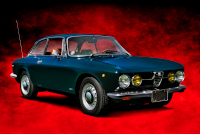Location:
Radnor Hunt Concours d'Elegance, 2023
Owner: Lorenzo Tarantino | Millstone, New Jersey
Prologue:
Zagato's little duck—the theme bears some uncanny significance as we caught this car during a rainy 2023 concours. I returned to this JZ on a few occasions to re-compose images as the droplets subsided, but in retrospect a bit of water on the body seems appropriate.
The Junior Z is an oddity, never an American export, and of a period that now enjoys recognition for its sharp design ethic. And while the Giulia, GTA, and Spider all contributed to the American impression of cute and classy Italian motoring, the JZ did not. So the car's obscurity—its simple funky form—lingered outside of our purview just long enough to become charming on first acquaintance.
What we find in our mean research is that the Junior Z enjoys its own clan of obsessive disciples, so I will try not to upset their enthusiasm with this profile. The car demonstrates a stroke of Ercole Spada wizardry in an era of unit-body production, which, for want of a custom vehicle, created a problematic manufacturing process, which in turn led to the car's aforementioned obscurity.
But problems are the spice of history, what we tend to value later on because we appreciate the effort. Overlooked no longer, the Junior Z is one such whiz.
- - - - - - - - - -
► Image Source: Nikon D750 (24.3 MP)
References:
- Czap, Nick. "Museo Storico Alfa Romeo: The catalogue" Giorgio Nada Editore, Milano, Italia. 2015, page 147
- Zagato Cars: Jack Habits, Netherlands, provides a wealth of information on the GT 1300 Junior Z, including a registry that includes #AR1800425.
- Bonhams: An August 2024 auction listing for #AR1800256.
- Petrolicious: Boér, Máté. "An Alfa Romeo 1600 Junior Zagato and The Payoffs of Patience," August 18, 2020
- Sports Car Digest: Minasian, Raffi. "The Alfa Romeo Junior Zagato - The Perfect Car for Tomorrow," February 21, 2022
- Italclassic: The Alfa Romeo 105 series model guide.
With the Spider and Junior designs dolled out to Pininfarina and Bertone, the job of the lightweight falls to Zagato, continuing Alfa Romeo's habit of dispersing design briefs among Italian coachbuilders. In 1967, Alfa Romeo President Giuseppe Luraghi enlists Gianni and Elio Zagato, who in turn enlist Ercole Spada to design the new car. A bit of a contradiction, the Junior Z is spartan, yet exclusive. Simple at a glance, yet packed with clever design features.
Alfa Romeo present the GT 1300 Junior Z at the Salone di Torino in 1968, and the car enters production the following year; it is a special GT based on the 1300 Spider Junior with mechanicals shared among that open car and the standard GT 1300 Junior berlinetta. Part of the 105 series, the production code is 105.93.
Spada's postmodern shape achieves somewhat limited popular exposure at the fault of the car's complex manufacturing process. But automotive designers do take note, and the Junior Z bears influence on popular trends well over a decade later.
Junior Z: A Simple Car Produced in the Most Complex Way
By now the Junior Z production story has circulated widely, primarily scripted by Dutch Alfa Romeo owner and researcher Jack Habits, with deference to historian Luigi Fusi. The story is important to understand the car, both in terms of what it is and why there aren't more of them.
Alfa Romeo produces the 1300 platform in Arese. In 1969, the Arese factory allocates a small number of unit-body 1300 Spider Junior platforms for the Junior Z. Although the Junior Z is a closed coupe, the spider's short dimensions suit Ercole Spada's compact design. Arese stamp these platforms with serial numbers specific to the Junior Z model, then send them to Zagato's factory in Terrazzano di Rho.
Zagato keep the new Spider Junior platforms outside their Terrazzano factory, a delay caused in part by the desire to only build cars against customer orders, and also by the need to modify them to accept the Junior Z body. This process involves removing the rearward floor and inserting a shorter boot section, the Junior Z tail being so drastically truncated. Zagato then send the modified platforms to Maggiora, a third manufacturer in Torino.
Maggiora construct the Ercole Spada-designed body, creating a finished shell, which they attach to the modified platforms that arrive from Terrazzano. Maggiore then send the assembled bodies and platforms back to the Alfa Romeo factory in Arese.
Alfa Romeo apply a primer coat to the bodies, then send the car back to Zagato in Terrazzano di Rho. Zagato apply a proper acrylic coat and finish the exterior and interior trim.
To recap, the itinerary is: Arese, Zagato, Maggiora, Arese, Zagato. A few variations appear in online articles and forums, but I believe this is the correct process.
A few idiosyncrasies result from the general Junior Z plan. First, the shortened tail section requires a fuel tank unique to the model that in turn moves the fuel filler to the right side of the car, a trait shared only with the Montreal among 105 series cars.
Second, Zagato randomly modify available platforms waiting outside their factory, and Maggiore do not particularly mind the order in which they receive modified platforms for assembly, which creates record-keeping chaos in terms of serialized production. So, whereas Alfa Romeo would produce automobiles of sequential serial number, no such organization applies to the Junior Z. A surplus of unfinished platforms seemed to confuse Alfisti for some while, though Habits confirms #AR1801110 is the final car built of 1,108 units.
From Saab to Honda: Ercole Spada and the Junior Zagato Influence
The most immediate Junior Z imitation arrives in 1970 via the Saab Sonnett III, a redesign of a front-drive hatchback platform that seems already headed in the direction Ercole Spada nailed down a year or so earlier.
This Swedish project, with credit shared between Sergio Coggiola and Gunnar Sjögren, already uses similar proportions but with a more classically inspired glasshouse and pontoon fenders. Spada's design exercise provides the green light to reduce these elements, pinch the nose into a dart, and harden the tail. Saab then aims the Sonnett III at the American market, which doesn't work very well despite our relative ignorance of the Alfa Romeo that sparked the design.
While US shores won't receive the Junior Z in period, Japan does collect a fair number of new examples; these lead directly to the development of the Honda Civic CR-X in 1983. The first CR-X uses a wheelbase 50 mm shorter than the Junior Z, straightens the lines in deference to prevailing trends, and packages 1.3 and 1.5 litre front-drive transaxles.
Numerous sources comment that a Honda engineer owned a Junior Z at the time; details and names remain elusive, but the connection is legitimate. If the Junior Z fits within the trend of postmodern designs at home in Italy, that trend lives on at Honda from the original Kamm-tail CR-X to the last CR-Z adaptation in 2016. Along the way, the 1999 Honda Insight demonstrates the same lightweight aerodynamic principles, a car that pundits have given some attention of late for its surprisingly pleasant driving characteristics.
So there exists a popular class of compact Honda automobile that has shared our roads for over 40 years, and we owe that lineage to the principles that Ercole Spada, Zagato, and Alfa Romeo brought together in the late 1960s.
Junior Zagato Chassis #AR1800425
The example depicted here is, like many, an original Italian-registered vehicle. Mister Tarantino acquired the car from Gabriele Valerio in Saronno, (same as the Amaretto liqueur), which is little more than five miles from Arese. So this Junior Z had not wandered very far from home before its migration to the US.
Paint is Giallo Oro, or AR 117 Giallo Zagato, over a black interior.
In our present mode of historical reverence, the Junior Z is a car for which enthusiasts waited to become old enough for import in lieu of the safety regulations that kept it hidden from popular consciousness in period. Yet its obscurity persists, a footnote in the series 105 catalogue, albeit one of lasting influence.
Motor: 1,290 cc inline 4-cylinder, light alloy block and head | 74 mm x 75 mm | 9.0:1 compression
Valvetrain: DOHC, chain-driven 2 valves per cylinder
Aspiration: twin Weber 40 DCOE side-draft carburetors
Power: 103 bhp @ 6,000 rpm | 101 lb ft torque @ 6,000 rpm
Drivetrain: 5-speed gearbox, hydraulic single-plate clutch, rear-wheel drive
Front Suspension: independent wishbones, oblique arms, coil springs, hydraulic dampers, and anti-roll bar
Rear Suspension: live axle with trailing links and T-reaction trunnion, coil springs. hydraulic dampers, and anti-roll bar
Architecture: pressed steel unitary construction with steel body panels by Zagato of Terrazzano di Rho, Lombardia
Some examples use an alloy bonnet and doors whereas some use an all-steel body. The body panel material actually influenced the door handle design, which originally used separate aluminum pockets that maintained the car's overall cleanliness of form. These pockets reacted poorly when attached to the steel, giving way to the black devices shown here on #AR1800425.
Kerb Weight: 969.78 kg (2,138 lbs)
Wheelbase: 2,250 mm (88.58 inches)
Top Speed: 175 km/h (108.7 mph)
Etymology:
Somewhat peculiarly, the small-capacity line of 105 series cars begins with 'GT' before announcing the 1300 cc displacement. 'Junior' appends the name to indicate the lesser adaptation of 1600, 1750, and 2000 cc motors. In this respect, the 1600 cc 105 series dates back to the 1962 Giulia Ti, and the 1300 cc 105 series dates back to the 1964 Giulia 1300. Alfa Romeo did not always use the 'Junior' moniker for its 1300 cc 105 series cars.
The 'Z' in 'GT 1300 Junior Z' indicates Zagato's contribution to the 105 series, a rather special project among its siblings. Fans also refer to this car as the Junior Zagato or simply the JZ.
The contemporary GT 1300 Junior family includes the Spider by Pininfarina, which lends its platform to the GT 1300 Junior Z, and the GT 1300 Junior, the traditional berlinetta designed by Bertone.
Figures:
According to Luigi Fusi, Alfa Romeo produced 1,108 of the GT 1300 from 1970 to 1972, perhaps fewer than they wanted, and unfortunately far more than the GT 1600 Junior Z that was supposed to do better.
Little Duck: Ercole Spada's Hatchback Special
Although the design appears simple, simplicity cannot be achieved so easily while retaining good proportions on a small platform. The Junior Z looks part of the Giulietta SZ Coda Tronca and Giulia TZ lineage, but with postmodern intentions. Spada truncates the tail to a massive extent while accentuating the nose, yet the hatchback plan keeps enough volume over the rear wheels to maintain visual balance.
In this respect, Máté Boér's article notes that Ercole Spada didn't like the design changes of the GT 1600 Junior Z. "Namely, he said that the balance of the initial shape was ruined by the longer rear overhang." And true or not, I agree. It is a strange declaration, that extending the tail of a car whose nose is already so much longer in relation would somehow ruin the balance, but "balance" in this case does not mean "equal," it means "correct."
The GT 1300 Junior Z design offsets its elongated forward bias with high hatchback volume to create an angular perspective. The GT 1600 Junior Z draws the eye back down at the tail, which diminishes both the long nose and the high hatch. So the Junior Z design is a case in which the measure of the tail must be diminished in order to set the greater dimensions of the nose and hood in harmony.
Dart versus Wedge: Differences in Early 1970s Italian Design
While much will be said about the wedge trend in Italy at this time, the Junior Z appears more of a dart—little and light, nothing so drastic as Marcello Gandini's Stratos Zero or Paolo Martin's Modulo. Spada's approach does fit the zeitgeist, (and we point out how the proportions create an angular perspective), but Spada's concept drawings suggest an altogether practical idea. Different than the wedge practice, his concept rather emphasizes the lateral shaping of the car, evident when viewed head-on.
The design tapers at the edges, creating a gentle bow over the bonnet, mirrored by the up-turned grille and guards, and echoed by the steeply raked windscreen and small hood area. Overall, the concept feels like a chiseled egg, whereas the wedge trend is much more about blades and planar surfaces. So despite its tidy belt line creases, the Junior Z simply uses too much lateral contour to be called a wedge.
But perhaps this much is academic, as no front-motor automobile can truly achieve what the mid-mount supercars could.
Clever Design: Hidden Features of the Junior Z
The look-twice elements of Spada's design create such charm that one enjoys combing the car for new details. Among the first, to my eye anyway, is the origami that conceals the wiper blade pivot in front of the driver. These folds blend into a gently raised lip that kicks air upward across the windscreen, with the opposing wiper tucked underneath.
Aerodynamics being a strong emphasis, the care of shrouding the wiper blades so that they do not create turbulence is a remarkable thought, and one that automakers will not broadly adopt until many decades later.
Along the flank, keeping with the lateral contour theme, the rear quarter windows curve up over the rear hatch. The windows are not straight because the cabin is not angular but instead curved through the shoulders. So using curved glass wraps the eye around the tail, which narrows in a manner similar to the nose.
The hatch itself appears rectangular, but is again slightly narrower than the cabin, allowing the body to wrap gently toward the back deck. And the Kamm tail uses a degree of rearward bias to match the angle of the B-pillars. An electrically driven motor props the hatch open to aid cabin ventilation, (which on this occasion helps dissipate the glasshouse humidity on a particular rainy September day).
Inside, the seats use a mid-back design with adjustable headrests, the upper portions open to the rear and the side braces raked back in keeping with the body shape. The seat forms mimics th uniform sling-back chair seen in the Lamborgini Miura, but in two pieces with the headrest floating above. These seats appear to be a derivation of the 1300 Junior, but with the panache of a limited production special.
Perspex Nose: Zagato Aerodynamic Wizardry
Deserving its own recognition, a perspex shield reduces drag caused by the grille's concavity. Zagato moulded its name down on the lower right edge of the cover, suggesting that the design feature is rather iconic of the model.
In lieu of the chrome shield seen on virtually every 105 series car of the period, the Junior Z uses a negative space concept. The central shield cut-out is not aerodynamically prudent, but the motor does require fresh air to breathe. To help, a column of eight oval vents provides airflow on the intake side.
Others have noted that these small ovals appear similar to the oval accents on the C-pillars of the Montreal, which debuts in 1970. But apart from practicality, one could surmise that the oval dates back to the kidney-shaped vents of the original 8C 2300 grille shroud, and that these accents were already nostalgic when new.
More pertinent, a set of ten oval cut-outs form a horizontal stencil on the rear guard, which at certain angles provides unexpected complexity as when looking across the tail over the exhaust tip. In this way the tail motif balances the nose.
Last Updated: Mar 26, 2025

